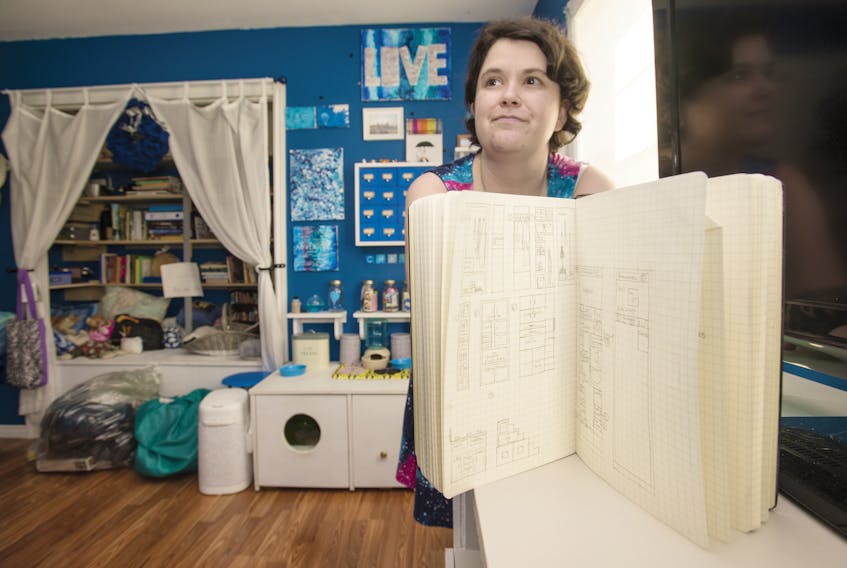After getting two college diplomas, 24-year-old Chelsea Pettipas is dreaming of buying her own custom-built home – and she has it all figured out.
Dozens of sketches show exactly where her bedroom, kitchen, dining area, bathroom and laundry facilities will be.
But the Pictou County, Nova Scotia Millennial isn’t planning on saddling herself with debt for the next 20 years just to get into her own place.
“What I’m planning to do is buy myself a school bus,” Pettipas said. “I’m looking online about how to convert them and my dad knows people who have converted them.”
Admittedly, it’s not for everyone but converting school buses is something that’s been done by others, sometimes with spectacular results.
In South Carolina, for example, a Millennial couple bought and converted a school bus and then moved into it year-round with their young daughter.
That schoolie, which is what these school bus homes are called, has only 220 square feet of living space but includes two beds, a full bathroom, a kitchen, dining area, and a sofa which folds out into a guest bed. That home on wheels uses solar for its electrical needs.
Schoolies and the growth of interest in tiny homes, some of them having as little as 200 square feet of living space, are emerging trends, especially with Millennials, who want to own their own homes but refuse to be straddled with decades of debt and mountains of interest to pay off.
“My mind is made up,” said Pettipas. “I don’t want to rent. I want to own. It doesn’t make sense to me to keep making payments on something that I’m not going to end up owning.”
She figures she can buy a school bus at auction for under $1,500. The renovations, which she plans to do herself with the help of family and friends, are expected to run her another $18,500.
The total cost of the project? $20,000.
That’s a lot less than the average cost of a house or condo, even if Pettipas does what she hopes to do and buys herself a lot on which to permanently park her schoolie. And it would mean Pettipas could be living in her own home debt free sooner than many other Canadians.
According to the Living Big in a Tiny House website, www.livingbiginatinyhouse.com, 68 per cent of tiny house owners are mortgage free compared to 29.3 per cent of other American homeowners. Tiny home owners can then put more aside in their savings accounts. A big source of saving for tiny house owners comes from being able to avoid interest payments on a mortgage.
Although houses cost less in Atlantic Canada than in many other parts of the country, paying the rent or mortgage is still a struggle for many in the region. According to the Financial Health Index released in November by Vancouver-based Seymour Management Consulting, 15 per cent of Atlantic Canadians worry about being able to cover the rent or mortgage.
And housing costs aren’t going down. They’re climbing.
According to realtor Royal LePage, home prices in Halifax are expected to climb another 2.5 per cent this year despite the new mortgage stress test that went into effect Jan. 1 and will make it harder for homebuyers to qualify for as big mortgages as in the past.
Royal LePage Atlantic president Matt Honsberger has gone so far as to say the Office of the Superintendent of Financial Institutions Canada’s stress test for mortgages is unlikely to have any sort of significant impact on Halifax’s housing market.
Other residential realtors agree.
In its housing market outlook, Re/Max is forecasting a two-per-cent bump in the average residential sale price, to almost $301,000 this year, up from just over $293,600, for the Halifax-Dartmouth area. Comparable housing in Charlottetown is expected to soar 13 per cent to hit just above $243,300.
The residential real estate markets in New Brunswick and Newfoundland and Labrador are expected to see fairly flat prices, with only condos going up. Saint John real estate prices are forecast to go up only one per cent, mostly driven by a seven-per-cent bump in the average condo price. In St. John’s, the average residential price is expected to stay the same even as condo prices rise eight per cent.
Among Millennials, some are turning to creative solutions to curb housing costs.
Scott Amirault, owner of Harvest Homes Renovations in Hampton, New Brunswick, makes tiny houses that look like cottages on trailers. So far, he’s made two, including one for Millennials who used it to keep their housing costs way down.
“It was for a young couple just starting out,” said Amirault. “They already had the land and the well and they were $28,000 all in.”
Although there are some places in Atlantic Canada where a homebuyer could pick up a house for as little as, well, $28,000, the tiny house builder says these are hardly deals.
“If you bought a house for that kind of money you would probably spend that much fixing it up,” he said.
The tiny houses he makes, though, are all brand-new material, with spray foam insulation in the walls, floors, and ceiling, and finished with solid wood siding to withstand being driven down the highway. They’re also designed using modern space-saving techniques.
“Every square inch matters,” said Amirault. “The steps that go up into the loft, they’re all storage and the cross beams that hold up the loft are made out of metal so you can save a few more inches. It also has a tiny kitchen but all the appliances are in it.”
In her home on wheels – fed with electricity from solar panels – Pettipas is planning to put all of the kitchen and cleaning facilities in the front of the bus, including a fridge, stove, washer and dryer, and cleaning closet beside the kitchen sink and counter. The clothes and linen storage will be across the aisle from a full bathroom in the middle of the bus. Her plans show the bed, bookshelves and a small place for her Bible will be in the back of the bus, below a skylight.
There’ll even be a special place for her three cats, Winnie, Ginger and Ozzy, and her Jack Russell terrier.
“If I can find a piece of land to put it on, I would like to park it,” she said. “Outside of the bus, I’m planning to make a big area with cat-proof and dog-proof fencing.”
Even with that land, Pettipas figures she can have her own home for less $36,000.
Her parents, though, still aren’t completely sure what to make of the idea.
“Do I want my daughter living in a school bus? Not really,” admits her mother Debi Pettipas. “It’s workable... but I don’t know. I’d have to go back and look at the research she’s done.”
Still Debi Pettipas applauds her daughter’s resourcefulness.
“I’m proud of her for thinking outside the box,” said Debi Pettipas. “It’s not like she’s got definite financial security so she’s thinking of other solutions.”
To see the schoolie: www.youtube.com/watch?v=o7X2nOtwdUM









